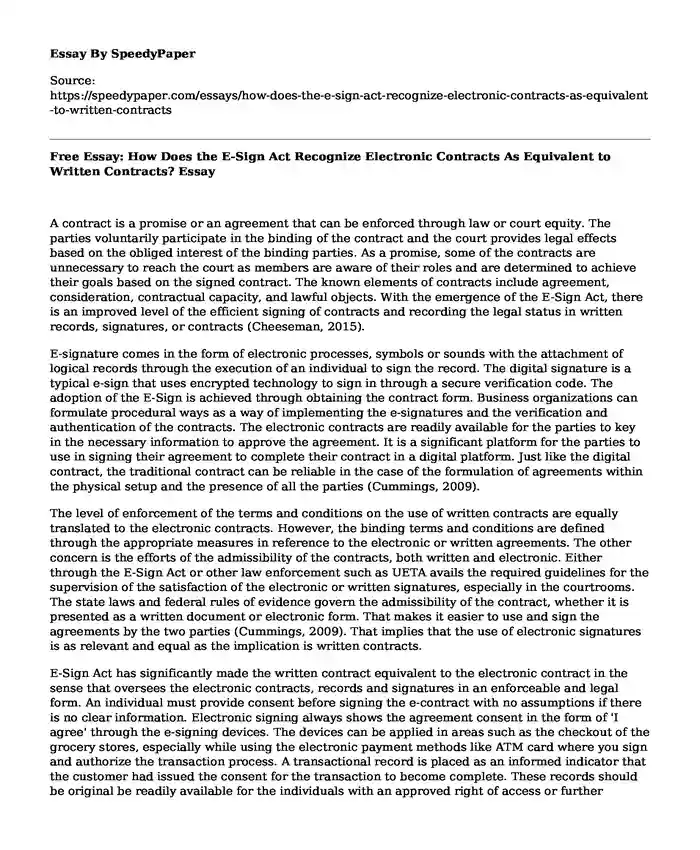
| Type of paper: | Essay |
| Categories: | Contract Information technologies |
| Pages: | 3 |
| Wordcount: | 600 words |
A contract is a promise or an agreement that can be enforced through law or court equity. The parties voluntarily participate in the binding of the contract and the court provides legal effects based on the obliged interest of the binding parties. As a promise, some of the contracts are unnecessary to reach the court as members are aware of their roles and are determined to achieve their goals based on the signed contract. The known elements of contracts include agreement, consideration, contractual capacity, and lawful objects. With the emergence of the E-Sign Act, there is an improved level of the efficient signing of contracts and recording the legal status in written records, signatures, or contracts (Cheeseman, 2015).
E-signature comes in the form of electronic processes, symbols or sounds with the attachment of logical records through the execution of an individual to sign the record. The digital signature is a typical e-sign that uses encrypted technology to sign in through a secure verification code. The adoption of the E-Sign is achieved through obtaining the contract form. Business organizations can formulate procedural ways as a way of implementing the e-signatures and the verification and authentication of the contracts. The electronic contracts are readily available for the parties to key in the necessary information to approve the agreement. It is a significant platform for the parties to use in signing their agreement to complete their contract in a digital platform. Just like the digital contract, the traditional contract can be reliable in the case of the formulation of agreements within the physical setup and the presence of all the parties (Cummings, 2009).
The level of enforcement of the terms and conditions on the use of written contracts are equally translated to the electronic contracts. However, the binding terms and conditions are defined through the appropriate measures in reference to the electronic or written agreements. The other concern is the efforts of the admissibility of the contracts, both written and electronic. Either through the E-Sign Act or other law enforcement such as UETA avails the required guidelines for the supervision of the satisfaction of the electronic or written signatures, especially in the courtrooms. The state laws and federal rules of evidence govern the admissibility of the contract, whether it is presented as a written document or electronic form. That makes it easier to use and sign the agreements by the two parties (Cummings, 2009). That implies that the use of electronic signatures is as relevant and equal as the implication is written contracts.
E-Sign Act has significantly made the written contract equivalent to the electronic contract in the sense that oversees the electronic contracts, records and signatures in an enforceable and legal form. An individual must provide consent before signing the e-contract with no assumptions if there is no clear information. Electronic signing always shows the agreement consent in the form of 'I agree' through the e-signing devices. The devices can be applied in areas such as the checkout of the grocery stores, especially while using the electronic payment methods like ATM card where you sign and authorize the transaction process. A transactional record is placed as an informed indicator that the customer had issued the consent for the transaction to become complete. These records should be original be readily available for the individuals with an approved right of access or further references and transmission in case of need. Generally, the use of the E-Sign Act presents an equivalent role as both written and electronic contract.
References
Cummings, A. (2009). Music piracy and the value of sound, 1909–1998. Columbia University.
Cheeseman, H. R. (2015). Contemporary business law. Pearson.
Cite this page
Free Essay: How Does the E-Sign Act Recognize Electronic Contracts As Equivalent to Written Contracts?. (2023, Nov 03). Retrieved from https://speedypaper.com/essays/how-does-the-e-sign-act-recognize-electronic-contracts-as-equivalent-to-written-contracts
Request Removal
If you are the original author of this essay and no longer wish to have it published on the SpeedyPaper website, please click below to request its removal:
- Digital Citizenship Essay Sample
- Free essay sample for students: Juan Mata's blog analysis
- Medical Healthcare Digitization: History of HL7 and FHIR Protocols, Essay Sample
- Paper Example. American Dream in Film Taxi Driver
- Free Essay. Electronic Health Records-Business Intelligence
- People Take Sports too Seriously - Essay Sample
- IRAN in Cyber Attacks - Essay Sample
Popular categories




